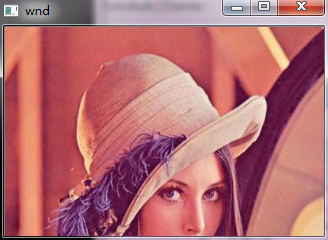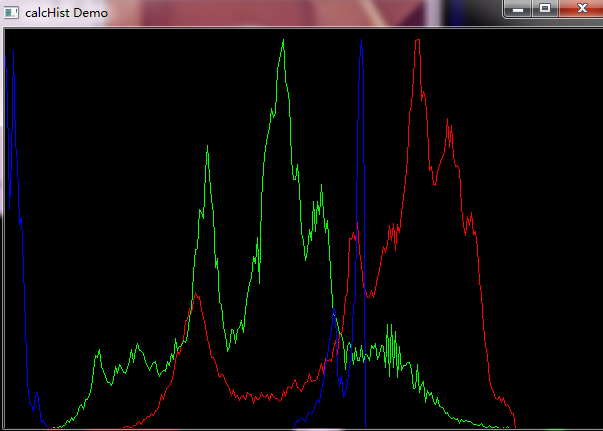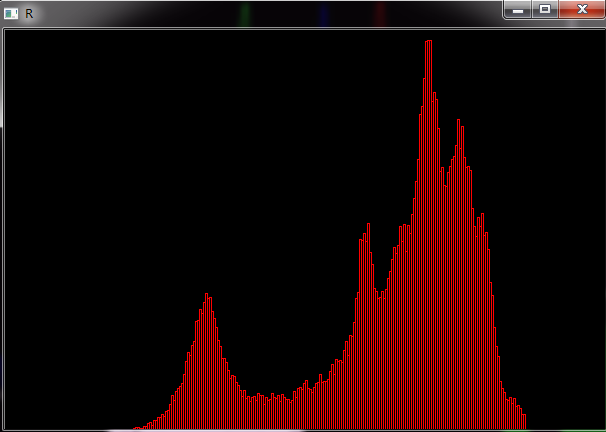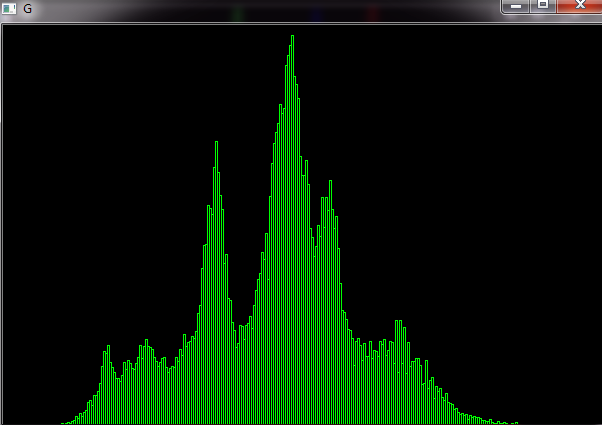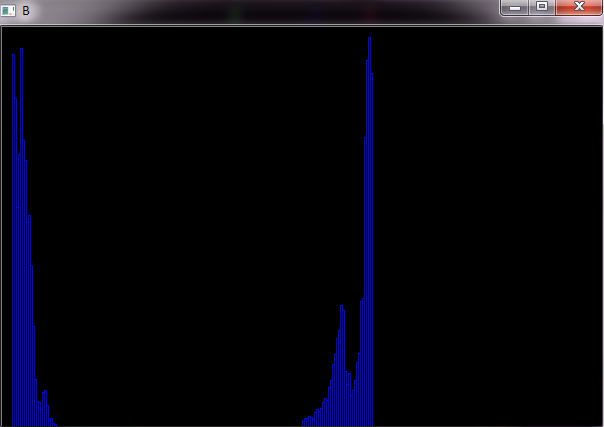
1 //////////////////////////////////////////////////////////////////////////////////////////// 2 ////Code Source 3 ////https://blog.csdn.net/ljbkiss/article/details/7412787 4 ////https://blog.csdn.net/ljbkiss/article/details/7420429 5 ////calcHist的使用+lena.jpg图像RGB3通道的normalize的直方图 6 //////////////////////////////////////////////////////////////////////////////////////////// 7 #include <opencv2/core/core.hpp> 8 #include <opencv2/highgui/highgui.hpp> 9 #include <opencv2/imgproc/imgproc.hpp> 10 #include <iostream> 11 12 //#pragma comment(lib, "opencv_core231d.lib") 13 //#pragma comment(lib, "opencv_highgui231d.lib") 14 //#pragma comment(lib, "opencv_imgproc231d.lib") 15 16 using namespace cv; 17 using namespace std; 18 19 #define HIST_DIM1 20 21 int main(int argc, char** argv) 22 { 23 #ifdef HIST_DIM1 24 //----------------------example 1-------------------------------// 25 Mat src, dst; 26 /// Load image 27 src = imread("d:/lena.jpg"); 28 29 if (!src.data) 30 { 31 cout << "load image failed" << endl; 32 return -1; 33 } 34 35 /// Separate the image in 3 places ( R, G and B ) 36 vector<Mat> rgb_planes; 37 #define SHOW_HSV 38 39 #ifdef SHOW_HSV 40 Mat hsv; 41 cvtColor(src, hsv, COLOR_BGR2HSV); 42 split(hsv, rgb_planes); 43 #else 44 split(src, rgb_planes); 45 #endif 46 /// Establish the number of bins 47 int histSize = 256; 48 49 /// Set the ranges ( for R,G,B) ) 50 float range[] = { 0, 255 }; 51 const float* histRange = { range }; 52 53 bool uniform = true; 54 55 bool accumulate = false; 56 57 Mat r_hist, g_hist, b_hist; 58 59 /// Compute the histograms: 60 calcHist(&rgb_planes[2], 1, 0, Mat(), r_hist, 1, &histSize, &histRange, uniform, accumulate); 61 calcHist(&rgb_planes[1], 1, 0, Mat(), g_hist, 1, &histSize, &histRange, uniform, accumulate); 62 calcHist(&rgb_planes[0], 1, 0, Mat(), b_hist, 1, &histSize, &histRange, uniform, accumulate); 63 64 // Draw the histograms for R, G and B 65 int hist_w = 600; 66 int hist_h = 400; 67 int bin_w = cvRound((double)hist_w / histSize); 68 69 Mat rgb_hist[3]; 70 for (int i = 0; i<3; ++i) 71 { 72 rgb_hist[i] = Mat(hist_h, hist_w, CV_8UC3, Scalar::all(0)); 73 } 74 75 Mat histImage(hist_h, hist_w, CV_8UC3, Scalar(0, 0, 0)); 76 77 /// Normalize the result to [ 0, histImage.rows-10] 78 normalize(r_hist, r_hist, 0, histImage.rows - 10, NORM_MINMAX); 79 normalize(g_hist, g_hist, 0, histImage.rows - 10, NORM_MINMAX); 80 normalize(b_hist, b_hist, 0, histImage.rows - 10, NORM_MINMAX); 81 82 /// Draw for each channel in one image 83 for (int i = 1; i < histSize; i++) 84 { 85 line(histImage, Point(bin_w*(i - 1), hist_h - cvRound(r_hist.at<float>(i - 1))), 86 Point(bin_w*(i), hist_h - cvRound(r_hist.at<float>(i))), 87 Scalar(0, 0, 255), 1); 88 line(histImage, Point(bin_w*(i - 1), hist_h - cvRound(g_hist.at<float>(i - 1))), 89 Point(bin_w*(i), hist_h - cvRound(g_hist.at<float>(i))), 90 Scalar(0, 255, 0), 1); 91 line(histImage, Point(bin_w*(i - 1), hist_h - cvRound(b_hist.at<float>(i - 1))), 92 Point(bin_w*(i), hist_h - cvRound(b_hist.at<float>(i))), 93 Scalar(255, 0, 0), 1); 94 } 95 96 for (int j = 0; j<histSize; ++j) 97 { 98 int val = saturate_cast<int>(r_hist.at<float>(j)); 99 rectangle(rgb_hist[0], Point(j * 2 + 10, rgb_hist[0].rows), Point((j + 1) * 2 + 10, rgb_hist[0].rows - val), Scalar(0, 0, 255), 1, 8); 100 101 val = saturate_cast<int>(g_hist.at<float>(j)); 102 rectangle(rgb_hist[1], Point(j * 2 + 10, rgb_hist[1].rows), Point((j + 1) * 2 + 10, rgb_hist[1].rows - val), Scalar(0, 255, 0), 1, 8); 103 104 val = saturate_cast<int>(b_hist.at<float>(j)); 105 rectangle(rgb_hist[2], Point(j * 2 + 10, rgb_hist[2].rows), Point((j + 1) * 2 + 10, rgb_hist[2].rows - val), Scalar(255, 0, 0), 1, 8); 106 } 107 108 /// Display 109 namedWindow("calcHist Demo", CV_WINDOW_AUTOSIZE); 110 namedWindow("wnd"); 111 imshow("calcHist Demo", histImage); 112 imshow("wnd", src); 113 114 imshow("R", rgb_hist[0]); 115 imshow("G", rgb_hist[1]); 116 imshow("B", rgb_hist[2]); 117 #else 118 //----------------------example 2-------------------------------// 119 Mat src, hsv; 120 if (!(src = imread("d:/picture/lena.bmp")).data) 121 return -1; 122 cvtColor(src, hsv, CV_BGR2HSV); 123 // Quantize the hue to 30 levels 124 // and the saturation to 32 levels 125 int hbins = 60, sbins = 64; 126 int histSize[] = { hbins, sbins }; 127 // hue varies from 0 to 179, see cvtColor 128 float hranges[] = { 0, 180 }; 129 // saturation varies from 0 (black-gray-white) to 130 // 255 (pure spectrum color) 131 float sranges[] = { 0, 256 }; 132 const float*ranges[] = { hranges, sranges }; 133 MatND hist; 134 // we compute the histogram from the 0-th and 1-st channels 135 int channels[] = { 0, 1 }; 136 calcHist(&hsv, 1, channels, Mat(), hist, 2, histSize, ranges, true, false); 137 double maxVal = 0; 138 minMaxLoc(hist, 0, &maxVal, 0, 0); 139 int scale = 8; 140 Mat histImg = Mat::zeros(sbins*scale, hbins*scale, CV_8UC3); 141 for (int h = 0; h < hbins; h++) 142 { 143 for (int s = 0; s < sbins; s++) 144 { 145 float binVal = hist.at<float>(h, s); 146 int intensity = cvRound(binVal * 255 / maxVal); 147 rectangle(histImg, Point(h*scale, s*scale), Point((h + 1)*scale - 1, (s + 1)*scale - 1), Scalar::all(intensity), CV_FILLED); 148 } 149 } 150 namedWindow("Source", 1); 151 imshow("Source", src); 152 namedWindow("H-S Histogram", 1); 153 imshow("H-S Histogram", histImg); 154 #endif 155 //-------------------------------------------------------------------------// 156 waitKey(0); 157 destroyAllWindows(); 158 return 0; 159 }
运行效果:
